Happy Spring: a time which is celebrated in all cultures in many different ways from the Persian new year to the Christian resurrection. A time of the re birth, fertility and new beginnings with its symbolism of eggs, rabbits and new life.
How do you feel at this time of year as nature awakens from her slumber and you see all around you the signs of new life as buds burst forth from the trees, shoots push through the earth, the birds start making their nests and the days get longer. Do you too feel like you have more energy? Are you beginning to get active with new projects and ideas for the year? Or do you feel there is too much activity going on and you want to withdraw?
Even in these days of technological rhythms, artificial light, and city dwelling, I think that most of us are still hugely influenced by the seasons. Each season brings a different energy. This is the basis of the five element system in Chinese medicine, which I will explore in this blog. In a second blog I will look at the elements in a different way, drawing upon other traditions such as Auryveda and consider the element of space which is often missing from the Chinese system.
Chinese five elements: or movements of energy: water, wood, fire, metal and earth:
In ancient times, the elders looked at the world around and they saw that it was composed of basic forces. From the fire of the sun, to the water that connected all of the lands through the sea, it was seen that each force had its special power and needed the others to find balance.
Before we forgot that we are part of the natural world around us, our ancestors saw that these same elements from nature, reside within us. We are the microcosm of the universe around us which is the macrocosm.
The five elements in Chinese medicine are water, wood, fire, metal and earth and they each relate to one of the four seasons. The seasons represent the movement of Yin and Yang throughout the year and so represent cycles of expansion and contraction.
The simplest way of looking at Yin and Yang is to see the daily movement of energy: Yin night and Yang day. The Chinese character for Yin and Yang is a mountain with a sunny (Yang) and a shady (Yin) side: a beautiful way of representing constant change. Both always present, in differing amounts through each day and are constantly moving into the other. Yang is the energy of expansion and transformation. Yin is the energy of contraction and formation.
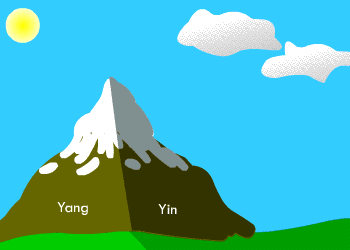
www.adroitinfosystem.com/ianm/the-concept-of-yin-yang/
Spring: wood: tree
Spring is the element of wood or tree: new life and creation. A tree is complex: it has a very Yin aspect, its roots anchored deep inside the earth. Its trunk is between Yin and Yang and its branches and leaves reaching up to the sky are very Yang. In many traditions the tree is used to represent all aspects of life as in the Tree of Life. Its direction is the East as the sun rises in the east and so it expresses the increase of Yang on the earth. Its taste is sour and its colour green.
It is essentially the energy of initiation, actively creating.
Wood is not in the Greek four element system or Auryvedic systems, I wonder if that is because it is essentially the beginning of the movement of Yang which will turn eventually into fire, summer, which is in all traditions. We need wood to make fire. As it also represents a movement from the earth to the sky, it can be considered to relate to Air.
Summer: fire
After spring we get the summer which is the fire. This is the peak of movement outwards, reaching to the sky. This is the maximum expansion of the Yang as the sun reaches its highest point in the sky, moving through the south. The days are at their longest. Firey foods tends to be spicy in a bitter way.
This is the expression of a project in its fullest flow: the fruits and flowers reaching their peak. It is a busy time of year when often people want to be outside more. Fiery hot cultures are often considered more sociable and fun loving. Party and connect! The colours are reds, and purples: vibrant colours.
Autumn: metal: gold or crystals and rocks
After summer the energy starts to draw back in as the days shorten and the sun is in the sky for less time. It is harvest time of the fruits of the earth, but also of the fruits of our labours: the completion of projects. Leaves fall from the trees to the earth where they settle. This is the movement back to Yin, an energy of contraction. Metal represents the crystals of the earth. The sun sets in the west so this is the direction of autumn. Its colours are either metal colours, or white and its taste pungent.
There is no metal in other systems but there is air. This might appear to be quite different from metal, since air is expansive: but we have to remember that the elements represent processes and it depends which stage of the process you are considering. Metal begins after Fire and is a movement of Air coming back to earth. In Chinese medicine (see my previous blog with metal) metal relates to the Lungs and breath: which of course also relates to air.
Winter: water
Metal carries on drawing in as winter approaches and the days shorten still more. This is the time when the natural world draws back into itself. The trees are bare and many animals go into hibernation. The sun is at its lowest point in the sky, so the direction is south. The days are colder and we may even get frost. The colours are blue and black and the taste salty. This is the most Yin time. The world is sleeping. However sleep is not passive. It is a different movement of energy. It is a time to integrate everything that happened in the year. It is essential to have a pause. This phase is probably the least valued and accepted in our culture. It is a time when nothing much seems to be happening, but in fact there is a different type of activity happening. This time is often related to our time in the womb. Growth is happening in the watery environment of the amniotic sac, set apart from day to day activity and hidden away. In hibernation our energies have time to build up. We process in a different way. We need to withdraw. Many cultures offered retreat spaces and valued this more inner time. It is a time where new things can begin and emerge.
Four seasons: five elements. Where is earth?
There are a couple of different ways in which earth has been placed in the seasons. In some views, earth comes after fire: represented by the season of the Indian summer and signifying the shift from the maximum movement of Yang turning towards Yin. In other traditions earth is said to be a season of transition between each season: a time of 18 days, allowing the energy to shift from one element to another. In another system earth is considered to be the centre. From all perspectives, earth is given the centre as the direction.
I like the idea of the centre being earth: without it none of the other elements could exist. It represents the earth herself, without which we wouldn’t have any seasons. However the other views are also valid. As earth is always there, then it serves as the basis for the other elements to pass through and of course the main shift from the outward movement of Yang to the inner movement of Yin is especially important. This diversity of viewpoints illustrates for me the richness of Chinese medicine. It is an expression of the energies of the living world and of course each person experiences the world differently. Sometimes people find it odd that Chinese medicine may appear to be contradictory: but isn’t life itself full of contradictions?
What then does earth represent? It is the earth on which we rest which nourishes and supports us in so many different ways. It is not by chance we often refer to the earth as our mother. Earth energy is also our human mother who nourished and supported us during our time in the womb as well as in our childhood years. Earth is a stable energy and the colours of earth are browns, yellows and golds. The flavour of earth is sweet.
When we consider earth as centre then we can see the axis of fire, water and earth as the vertical axis with fire above, relating to the heaven and facing south, earth in the middle relating to the earth and the centre and water below direction north, relating to our ancestral energy. This vertical axis is considered more stable and around it are the movement of metal and wood: which are not in included in non Chinese systems. In this way we get the formation of a cross symbol; which appears in many cultures representing the 4 seasons through the 4 equinoxes and the movements of the sun.
We could see wood as the energy moving up from the earth to the sky (air and space) and metal as moving down from the sky to the earth (also Air and Space) I am going to consider Air and Space in my second blog on Space.
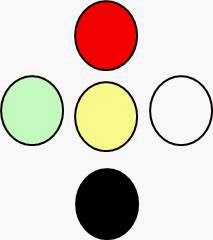
Credit: Maccicioa
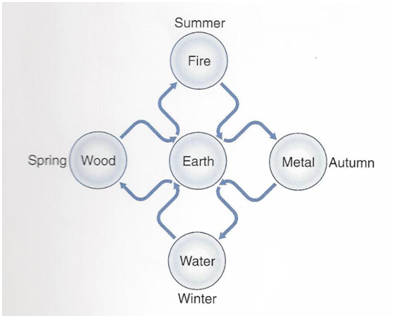
credit: http://www.easterncurrents.ca/
It was in a later time, earth was put after fire in a circle
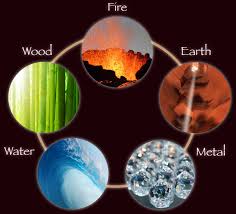
Credit: elemental woman.com
Beyond the seasons: the wider relevance of the elements
We can see that this movement of energy isn’t just about the seasons during the year, but simply a representation of any movement of energy from initiation to conclusion. The yearly cycle of seasons can be related to each day: we sleep (water: winter) we get up (wood:spring) we reach our maximum energy (fire: summer) we start to slow down (metal: autumn) and we go to sleep again. At any point in our day we may pause and rest and connect with the earth.
We could also view it as our journey through life: we grow in the womb (water), we are born and grow to maturity (wood), we reach our peak (fire) we start to harvest what we have done in our life (metal) and we start to slow down and eventually die, or, depending on our belief, go back to where we came from (water).
We can also apply it to a specific process. As I work a lot with pregnancy and birth, I often explain to my students that labour is a movement from the more Yin aspect of water (our time in the womb) to the more Yang aspect: first stage: dilation of the cervix). Women often connect with images of waves building in this stage. The energy of second stage is wood as the baby pushes out through the birth canal. This is following by bonding with the baby (fire) to letting go, separation, and drawing in (metal) and so back to a new cycle. Earth is the mother: and our point of reference for us while we are both inside and outside the womb.
Sometimes we feel more connected or less connected to a phase. It can be helpful to focus your attention on the different seasons and explore phases which you feel less connected with.
Activities to support wood in your body
Sitting by a tree: connecting to the element in nature
I find that often the most simple way to connect with the energy of an element is to find it in nature.
Find a tree: any tree, whichever one you feel most drawn to. Look at her. Notice her form. Walk around her. Then find a place to stand against her. Stop and pause. Deepen your breathing. Feel your body melting into her trunk. Can feel the power of the trunk?. What do you feel as you connect with the trunk? How is your breathing? Then begin to feel the tree roots reaching down into the earth, our mother. What do you feel as connect down as deep as you can? When you are ready reconnect back with the trunk and start to feel the quality of the branches and leaves reaching into the sky, our father. How do you feel now? Spend some time with the tree. Get to know her. Notice how you are changed by being with the tree.
Parts of body: an exercise Gall Bladder and Liver
In Chinese medicine each element relates to channels of energy of a particular pair of organs. For wood this is the Gall Bladder and Liver: how we store and distribute Blood and therefore our capacity to get blood to the muscles and ligaments and organs for yang activity
The Gall Bladder and Liver stretch we can imagine that we are a tree, our legs and feet are our roots going into the ground, our body is the trunk and our arms the branches and leaves.
It is a side stretch as wood is about flexibility, like the tree.
Gall Bladder and Liver meridian stretch.
Sit and bend one leg so that the foot comes onto the thigh of the other leg. Have the other leg extended. Extend your arms to the side and then twist your hips so that your arms are parallel to the ground and in line with your hips and the extended leg. You are facing your bent knee. As you breathe out, ease towards the side with the extended leg, keeping your hips in line with your arms. If you can reach and hold the ankle or toes of the foot of the extended leg, then do so. With the other arm, ease your shoulders back and look up to the hand.
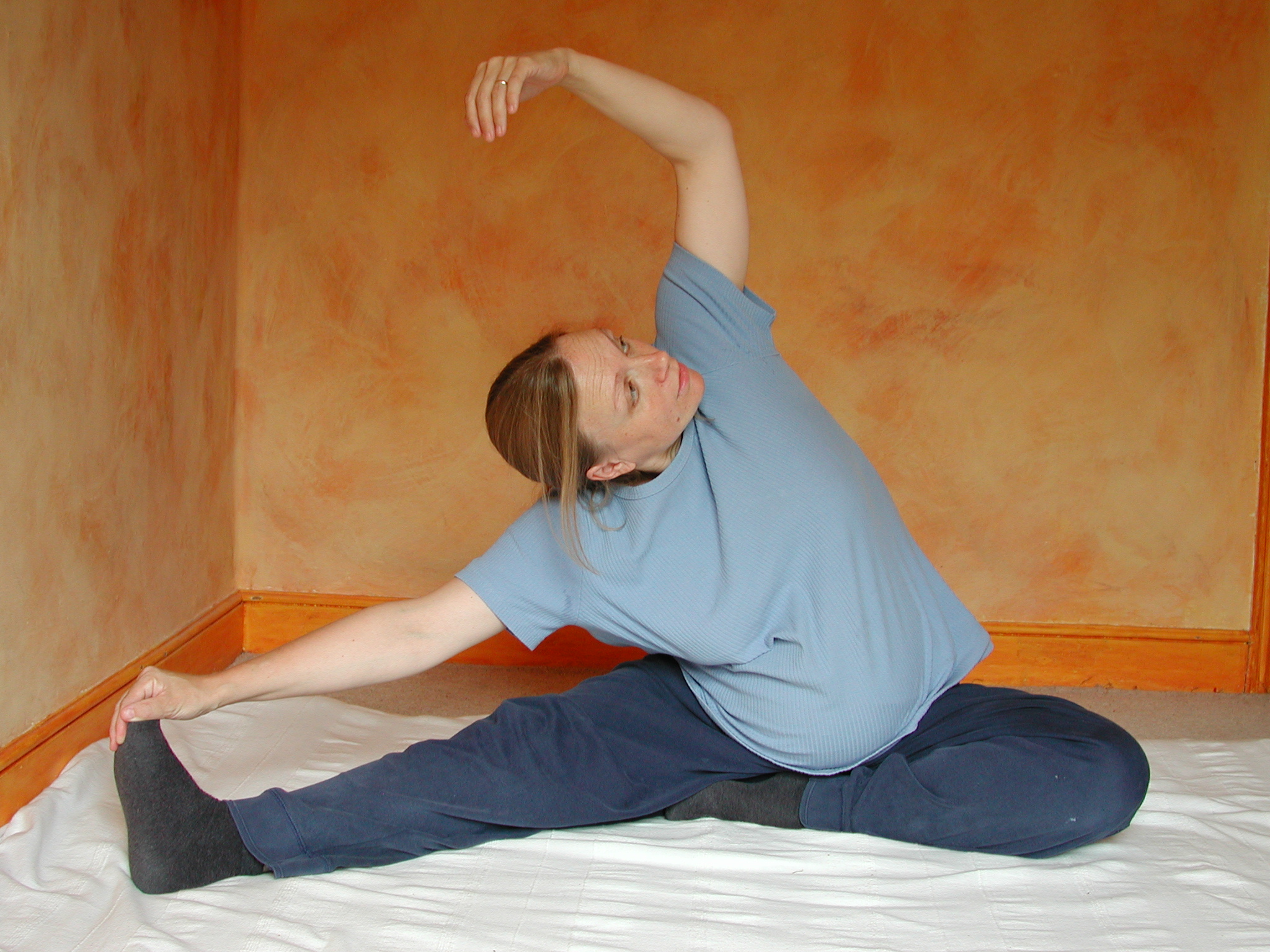 Liver and Gall Bladder stretch done by a pregnant woman: Shiatsu for Midwives by Suzanne Yates
Liver and Gall Bladder stretch done by a pregnant woman: Shiatsu for Midwives by Suzanne Yates
Journalling: reflection
Write down how you feel in the spring time. How do you feel as you do the above exercises. Wear green colours and notice how you feel in them. What aspects of wood do you feel drawn to? Not drawn to?
Quality of touch
If you are a bodyworker, then try doing some work feeling that your touch has the quality of tree: which aspect of tree do you want to incorporate. The roots, the branches or the trunk. How is it if you imagine working as tree?
How to explore more
I have organised, with my daughter (Rosa Lia, who through her studies in yoga and Auryvedic and Thai massage has an understanding of those ways of looking at the elements ) a day in May and a weekend in September to explore the elements in the countryside near Bristol. These two events are open to anyone interested in bodywork, not just therapists. The idea is to experience and live the different elements, spending time in different activities more than thinking about them and learning theory . We will be looking at the elements within Chinese medicine as well as drawing in some of the Indian and Tibetan traditions of the elements, which include air and space.
You can email Rosa (info@rosaliabodywork.com) or visit my website page ( https://www.wellmother.uk/resources/continuing-professional-development/exploring-the-elements
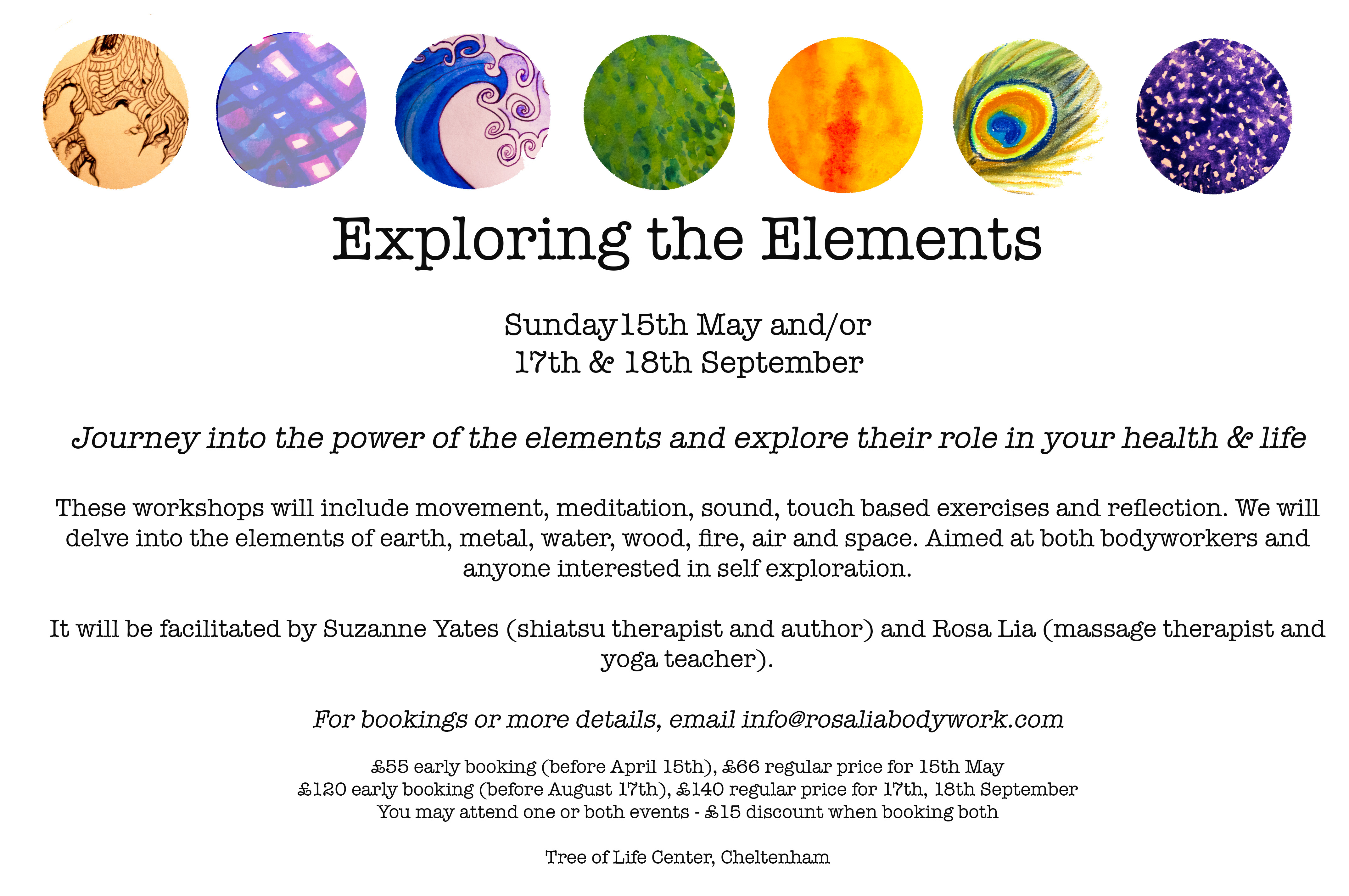



Reblogged this on ViVa Shiatsu, lo Shiatsu a Torino and commented:
Come gli elementi naturali lavorano nei nostri corpi.
La primavera: il periodo della rinascita, della fertilità e di un nuovo inizio.